Peripheral vision loss, often referred to as tunnel vision, is a condition where one loses the ability to see objects outside of the central vision. This can significantly impact daily activities and quality of life. In this article, we'll explore the symptoms, causes, and treatments for peripheral vision loss, providing valuable insights for those affected by this condition.
Understanding Peripheral Vision Loss
What is Peripheral Vision?
Peripheral vision refers to the ability to see objects and movement outside of the direct line of sight. This type of vision is crucial for daily activities such as driving, walking, and navigating through crowded areas. Here are some specific examples:
- Driving: Peripheral vision allows you to notice vehicles and pedestrians beside you. For instance, it helps you detect cars in your blind spot when changing lanes on a highway (Trobe, 2011).
- Walking: It helps you see obstacles or other pedestrians to avoid collisions, such as when walking in a busy mall or crowded street (Lee & Brazis, 2022).
- Sports: In sports, peripheral vision helps you see the actions of teammates and opponents. For example, in basketball, you can use peripheral vision to see teammates' movements and opponents' defensive actions (Taylor & Hoyt, 2017).
Losing peripheral vision can make these activities challenging and sometimes dangerous.
Symptoms of Peripheral Vision Loss
The symptoms of peripheral vision loss can vary depending on the underlying cause. Common signs include:
- Difficulty Seeing in Low Light: Struggling to see objects in dimly lit environments, such as driving at night (Ryan et al., 2017).
- Frequent Bumping into Objects: Colliding with things or people you didn’t see coming from the sides, like in crowded streets (Schneider, 2023).
- Reading Difficulty: Frequently moving your head or eyes to see an entire line of text, such as when reading newspapers or books (Yanoff & Duker, 2018).
- Locating Problems: Difficulty quickly locating objects or people moving from the side, such as shoppers in a supermarket (American Academy of Ophthalmology, 2020).
- Tunnel Vision: The sensation of looking through a narrow tube, where only the central vision remains clear. For example, you might only see what is directly in front of you and not the surrounding environment (National Eye Institute, 2023).

In most cases, peripheral vision loss doesn’t happen immediately and is a gradual process that gets progressively worse over time. Peripheral vision problems are not always easy to recognize, though, as they affect your field of vision (FOV) in a very specific way. There are two types of vision that make up how we see the world around us with healthy vision. The first is central vision, which refers to the objects that are directly in front of you, that are in the center of your vision when your eyes are pointed at something. This is where the eyes focus, which is why objects in this central vision are sharper and clearer than anywhere else in your vision range, even if you have completely healthy eyesight.

The second type of vision is peripheral vision. This is the area surrounding that central vision area, where your eyes are not as tightly focused, and it tends to be a little less sharp. Sometimes called side vision, it is what we see from the corner of our eyes and can be incredibly useful when driving, riding a bike, or engaging in any number of other activities.
It is this second area of vision, your peripheral vision, that is affected by peripheral vision loss. This may begin with blurry peripheral vision, or it could just seem darker towards the edges, reducing your field of vision so you can see less than you normally could.
As you lose side vision, the width of your overall vision decreases and you can see little beyond that central vision area. This is known as the tunnel vision effect. This is because it mimics the effect of standing in a dark tunnel looking out of the opening at bright sunlight. You see that central part clearly, but everything else is dark, indistinct, and lacking in clarity.
 This is the effect of peripheral vision loss, and it is really important to seek medical assistance if you notice any onset of the problem, even if it seems minor. You can take a peripheral vision test with your eye specialist if you have any concerns, but the good news is that many types of peripheral vision problems are treatable, and several causes of peripheral vision problems can be avoided altogether with sensible lifestyle choices.
This is the effect of peripheral vision loss, and it is really important to seek medical assistance if you notice any onset of the problem, even if it seems minor. You can take a peripheral vision test with your eye specialist if you have any concerns, but the good news is that many types of peripheral vision problems are treatable, and several causes of peripheral vision problems can be avoided altogether with sensible lifestyle choices.
If you experience any of these symptoms, it is essential to consult with an eye care professional for a thorough examination.
Causes of Peripheral Vision Loss
Here are some common causes of peripheral vision loss. Eye diseases are a significant issue for anyone because even minor problems can result in long-term vision challenges, and they are the main causes of peripheral vision problems. These include:
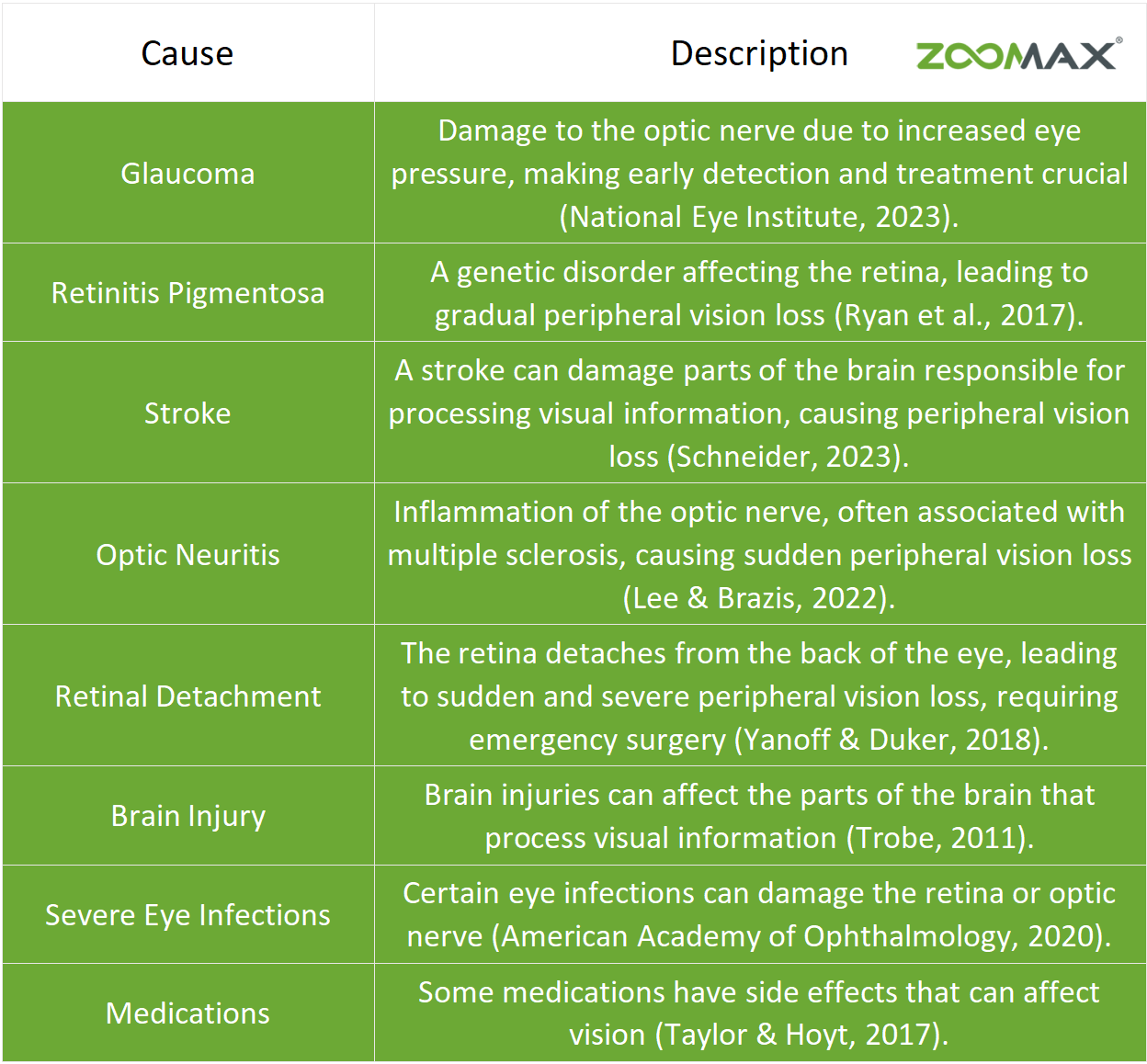
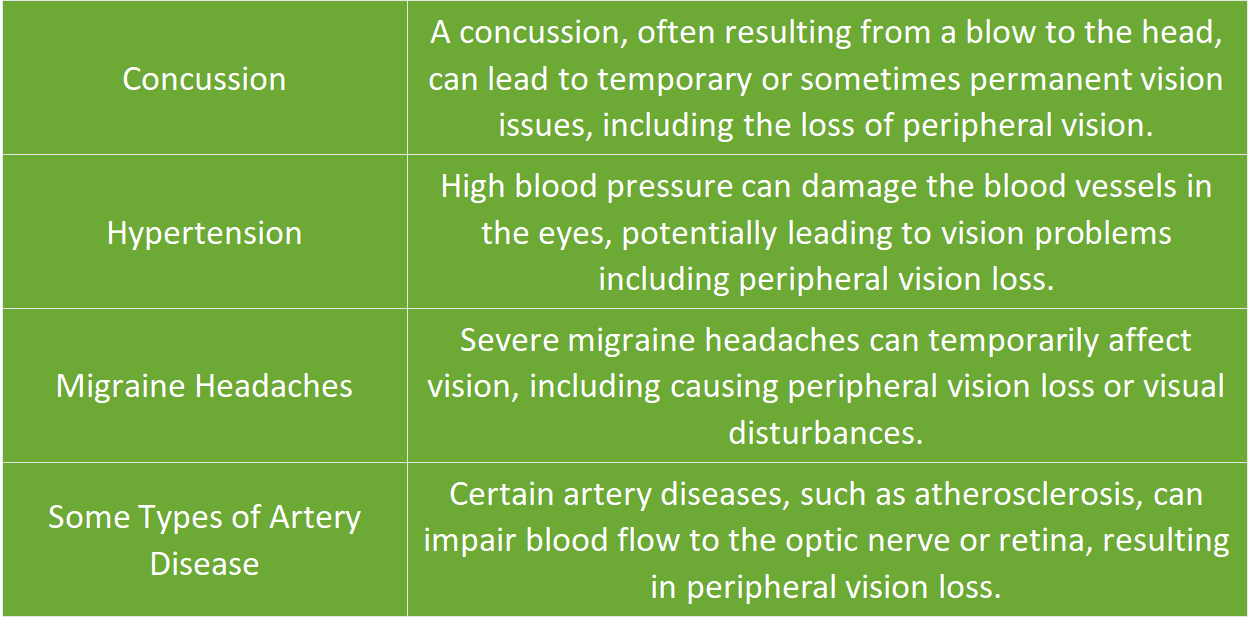
Glaucoma and various retinal eye diseases tend to cause permanent peripheral vision loss. However, in the case of many of these illnesses and diseases, the tunnel vision effect may be temporary. In all cases, it is crucial that professional medical help is sought immediately to ensure that everything that can be done to mitigate the issue is put into practice.
Diagnosis of Peripheral Vision Loss
.jpg)
Diagnosing peripheral vision loss involves a series of tests conducted by an eye care professional. These tests may include:
- Visual Field Test: Measures the extent of your peripheral vision and identifies areas of vision loss (Lee & Brazis, 2022).
- Ophthalmoscopy: Examines the retina and optic nerve for signs of damage (Ryan et al., 2017).
- Imaging Tests: MRI or CT scans may be used to identify any brain abnormalities affecting vision (Schneider, 2023).
Early diagnosis is critical for effective treatment and management of peripheral vision loss.
Three Peripheral Vision Field Tests
The best way to maintain your eye health and prevent eye diseases of all kinds, including the loss of peripheral vision, is by having regular eye exams. These allow your ophthalmologist to spot problems early, and with a treatable problem like tunnel vision, that can make all the difference. This is especially true for anyone suffering from diabetes, where annual eye exams should be a minimum, and can often be the difference in treating your vision problems.
There are three types of eye tests that can be useful in dealing with peripheral vision issues. These are:
Confrontation Visual Test
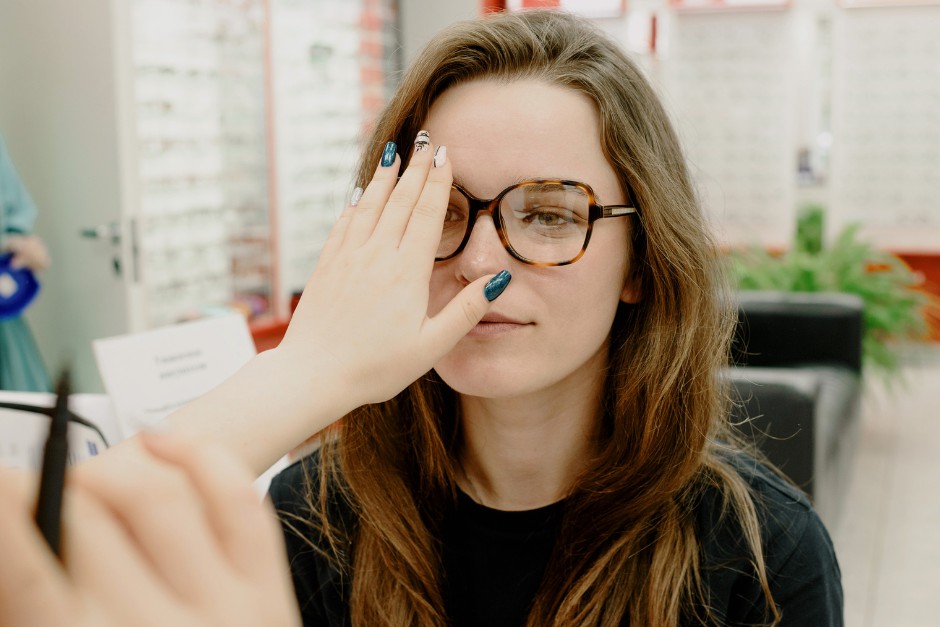 A simple test most people will be familiar with, it involves covering one eye and having the doctor or eye care technician hold up fingers for you to count within your peripheral vision. This is then repeated with the other eye. Simple and easy to administer, it gives a broad idea of the level of side vision someone has. However, as it uses no instruments for measurement, it may not always catch small side vision defects.
A simple test most people will be familiar with, it involves covering one eye and having the doctor or eye care technician hold up fingers for you to count within your peripheral vision. This is then repeated with the other eye. Simple and easy to administer, it gives a broad idea of the level of side vision someone has. However, as it uses no instruments for measurement, it may not always catch small side vision defects.
Automated Static Perimetry Test
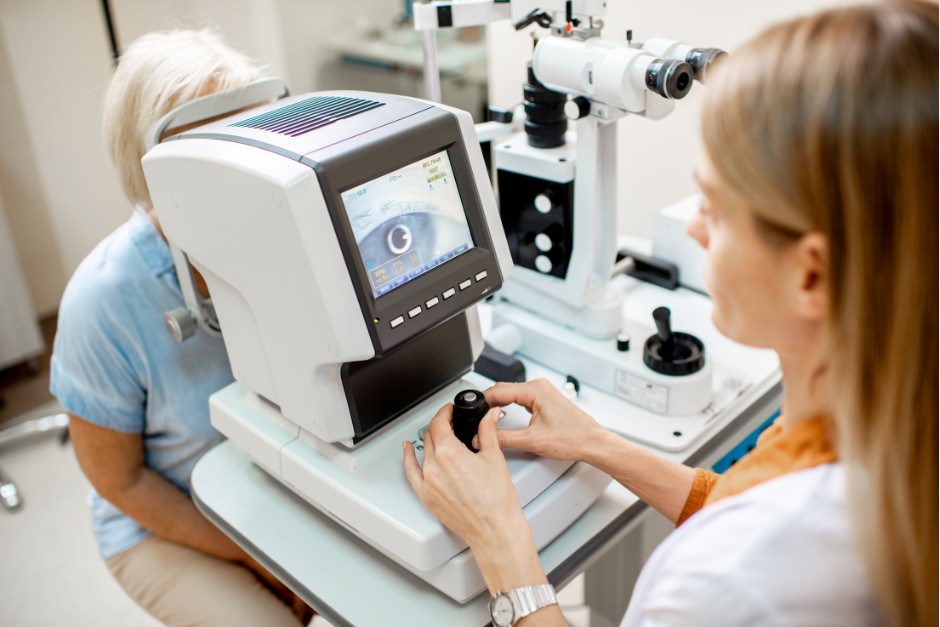 This test uses a device designed specifically to test peripheral vision, known as a Perimeter. One eye is covered, and the patient is asked to press a button every time they see lights appear. The lights are situated all around the area, in both central vision and side vision, and appear in a random order. Once the test is complete with one eye, it is repeated with the other. A failure to note when certain lights appear can highlight a loss of peripheral vision in certain areas, allowing the ophthalmologist to investigate further. This test is especially useful in identifying issues caused by glaucoma.
This test uses a device designed specifically to test peripheral vision, known as a Perimeter. One eye is covered, and the patient is asked to press a button every time they see lights appear. The lights are situated all around the area, in both central vision and side vision, and appear in a random order. Once the test is complete with one eye, it is repeated with the other. A failure to note when certain lights appear can highlight a loss of peripheral vision in certain areas, allowing the ophthalmologist to investigate further. This test is especially useful in identifying issues caused by glaucoma.
Kinetic Visual Test
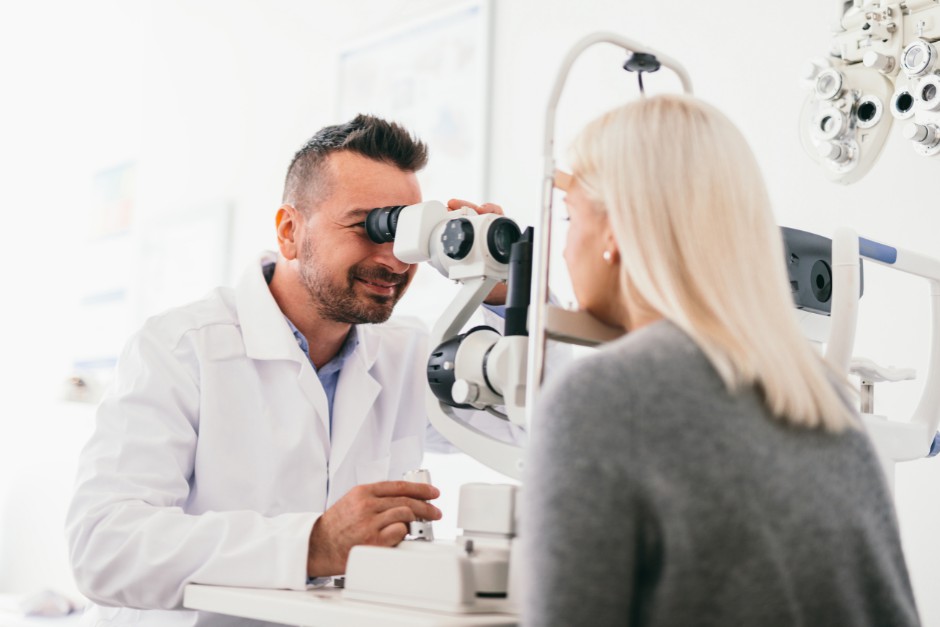 The last type of peripheral vision test also uses the same dedicated perimeter machine as the previous test. Here, though, light moves in and out of your side vision, rather than appearing in one place and disappearing after. This approach allows a more accurate understanding of where the issues with peripheral vision begin in terms of the field of view and is particularly useful for diagnosing retinal diseases and neuro-ophthalmological issues.
The last type of peripheral vision test also uses the same dedicated perimeter machine as the previous test. Here, though, light moves in and out of your side vision, rather than appearing in one place and disappearing after. This approach allows a more accurate understanding of where the issues with peripheral vision begin in terms of the field of view and is particularly useful for diagnosing retinal diseases and neuro-ophthalmological issues.
Vision health is also related to your overall health too, so eating sensibly, getting plenty of exercise and living a healthy lifestyle in general can have a huge impact. Protecting your eyes is also part of that, but with many issues that cause temporary peripheral vision loss associated with general lack of health, making the effort to maintain a healthier lifestyle really can be the best approach for eye health too.

However, there are some cases where peripheral vision loss is permanent, and here the goal is to help patients manage their condition to have as minimal an impact as possible. The vision aids of the Acesight E-glasses series, such as Acesight and Acesight VR are able to provide help for people with peripheral vision loss. This kind of visual aid is equipped with the narrow mode function, which allows the user to move the screen to a suitable place, in order to fit the tunnel vision situation. More information about Acesight and Acesight VR E-glasses is available on the official website: https://www.acesight.com/. With a wide range of technology to help, peripheral vision problems can be managed effectively and allow those with 20/200 vision to maintain their lifestyles and independence.
Treatments for Peripheral Vision Loss
While there is no cure for peripheral vision loss, several treatments can help manage the condition and improve the quality of life for those affected.

Medications
For conditions like glaucoma, medications can help reduce eye pressure and slow the progression of vision loss. These may include eye drops or oral medications (National Eye Institute, 2023).
Surgery
In cases of retinal detachment or severe glaucoma, surgical intervention may be necessary. Procedures such as laser surgery or vitrectomy can help restore or preserve vision (Yanoff & Duker, 2018).
Vision Therapy
Vision therapy involves exercises and activities designed to enhance visual skills and compensate for vision loss. This therapy can be particularly helpful for those with stroke-induced vision loss (Taylor & Hoyt, 2017).

Assistive Devices
Various assistive devices can help individuals with peripheral vision loss navigate their environment more safely. These include:
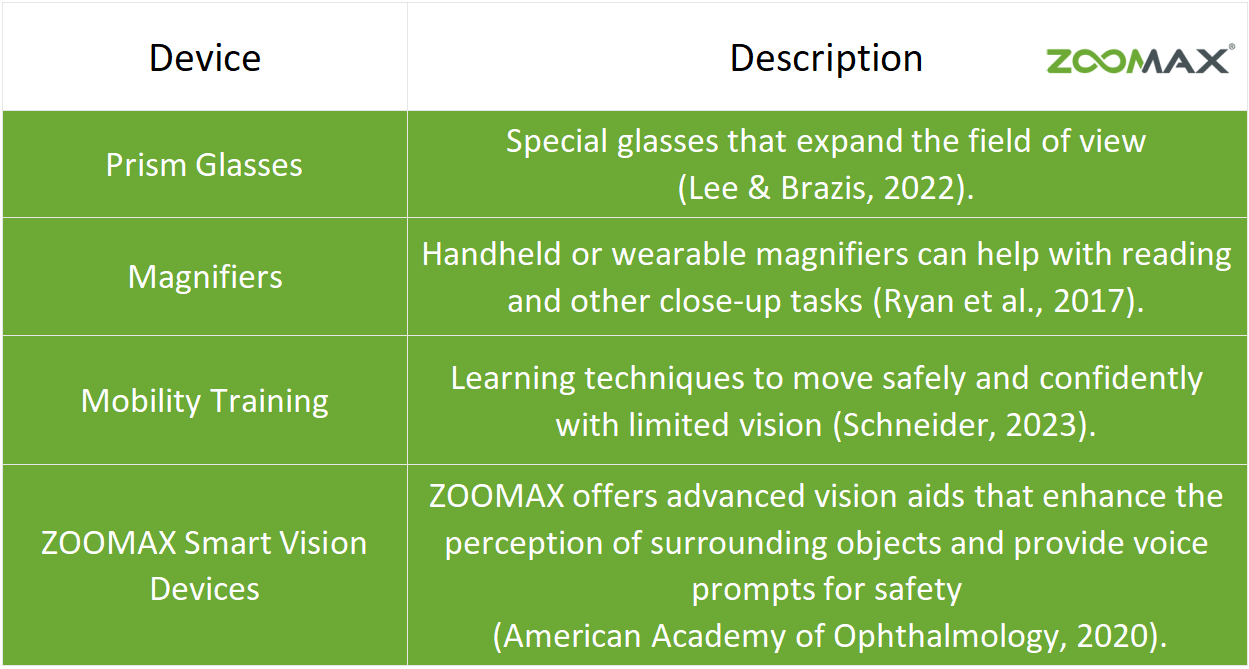
- Here are our currently best-selling handheld/desktop electronic magnification devices: Luna6 and Snow 12. You can watch the videos below by clicking on them.
- Special Glasses: Some glasses are designed to widen the field of view.
Lifestyle Adjustments
Making certain lifestyle changes can also help manage peripheral vision loss. These include:
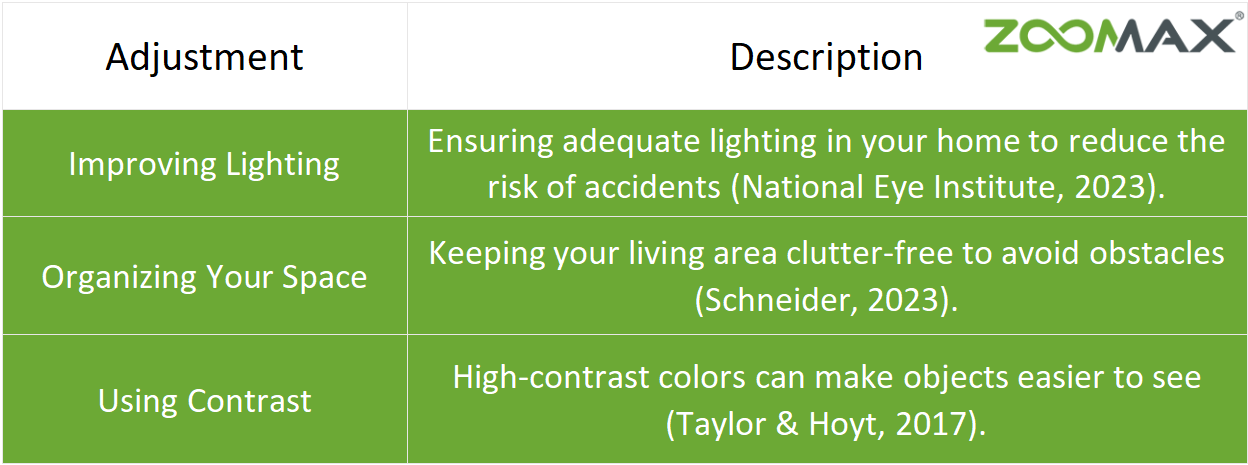
Coping with Peripheral Vision Loss
Living with peripheral vision loss can be challenging, but there are ways to cope and maintain a fulfilling life.
Support Systems
Building a strong support system of family, friends, and support groups can provide emotional and practical assistance. For example, joining support groups allows you to share experiences and receive advice and encouragement from others (Trobe, 2011).
Professional Guidance
Working with occupational therapists and low vision specialists can help you develop strategies to adapt to your vision loss. These professionals can offer personalized advice and training, such as using assistive devices or adjusting your home environment (American Academy of Ophthalmology, 2020).
Staying Active
Staying active is crucial for mental and physical health. Participating in adaptive physical activities or hobbies can enhance your quality of life. For instance, joining adaptive yoga classes, fitness programs, or indoor sports can help you stay active and healthy. Referencing a previous article, you might choose adaptive sports like swimming, walking, and mild aerobic exercises, which are excellent for cardiovascular health and enhance flexibility and coordination (for more informaiton please refer to this article: Safe and Enjoyable Exercise for People with Low Vision ) Staying active not only helps your physical health but also boosts your mood and overall well-being (National Eye Institute, 2023).
Conclusion
Peripheral vision loss, or tunnel vision, can significantly impact daily life. Understanding the symptoms, causes, and available treatments is essential for managing this condition effectively. Regular eye examinations and early intervention are key to preserving as much vision as possible. If you or a loved one are experiencing symptoms of peripheral vision loss, seek professional medical advice promptly. With the right support and resources, individuals with peripheral vision loss can lead active and fulfilling lives.
For more information and support, consider reaching out to local vision loss organizations and eye care professionals who can provide additional resources and guidance.
FAQs
Can peripheral vision loss be prevented? While some causes of peripheral vision loss, such as genetic conditions, cannot be prevented, regular eye examinations can help detect and manage conditions like glaucoma early, potentially slowing the progression of vision loss (Lee & Brazis, 2022).
How can I adapt my home for peripheral vision loss? Improving lighting, using high-contrast colors, and keeping your living space organized and clutter-free can help make your home safer and easier to navigate (Schneider, 2023).
Are there support groups for people with peripheral vision loss? Yes, many organizations offer support groups where individuals with peripheral vision loss can share their experiences, receive support, and learn coping strategies from others facing similar challenges (Trobe, 2011).
References
American Academy of Ophthalmology. (2020). Eye Health and Safety. Retrieved from https://www.aao.org
Lee, A. G., & Brazis, P. W. (2022). Neuro-Ophthalmology Illustrated. Philadelphia, PA: Elsevier.
National Eye Institute. (2023). Facts About Glaucoma. Retrieved from https://www.nei.nih.gov
Ryan, S. J., Schachat, A. P., Wilkinson, C. P., Hinton, D. R., Sadda, S. R., & Wiedemann, P. (2017). Retina (5th ed.). Philadelphia, PA: Elsevier.
Schneider, J. (2023). Living with Low Vision: A Resource Guide. New York, NY: Vision Foundation Press.
Taylor, D., & Hoyt, C. S. (2017). Pediatric Ophthalmology and Strabismus (4th ed.). Philadelphia, PA: Elsevier.
Trobe, J. D. (2011). The Neurology of Vision. Oxford, UK: Oxford University Press.
Yanoff, M., & Duker, J. S. (2018). Ophthalmology (5th ed.). Philadelphia, PA: Elsevier.
Park Slope Eye. (n.d.). What causes tunnel vision/peripheral vision loss? Retrieved from https://parkslopeeye.com/what-causes-tunnel-vision-peripheral-vision-loss/#:~:text=What%20is%20Peripheral%20Vision%20Loss,re%20in%20a%20narrow%20tunnel
Cleveland Clinic. (n.d.). Tunnel Vision (Peripheral Vision Loss). Retrieved from https://my.clevelandclinic.org/health/symptoms/24435-tunnel-vision-peripheral-vision-loss
Dean McGee Eye Institute. (n.d.). Peripheral vision loss: What is it and how to treat it? Retrieved from https://dmei.org/blog/peripheral-vision-loss-what-is-it-and-how-to-treat-it/

